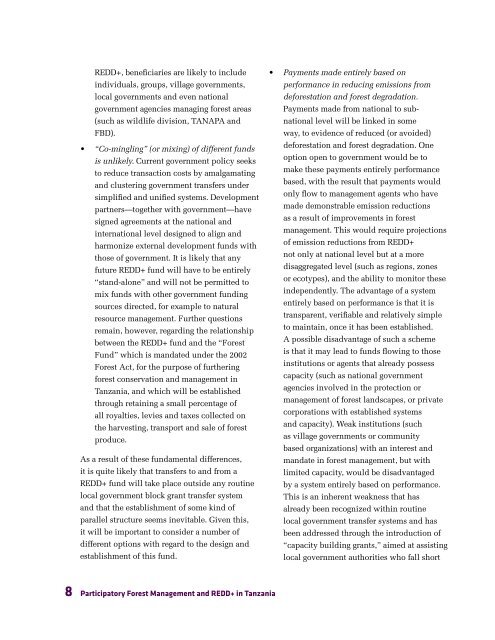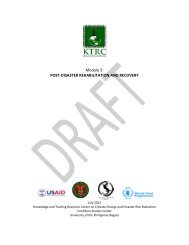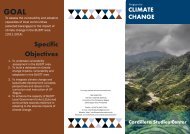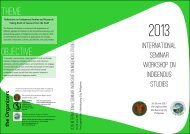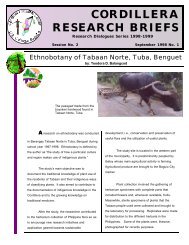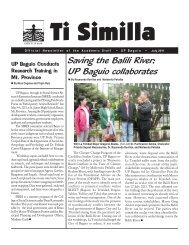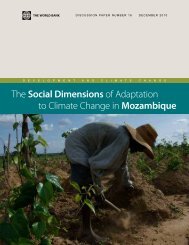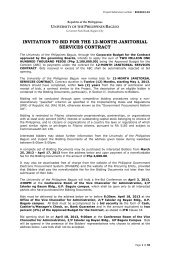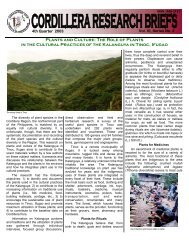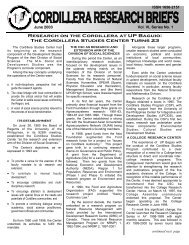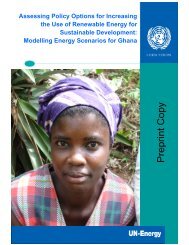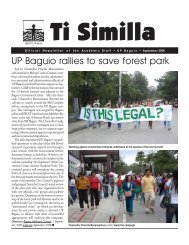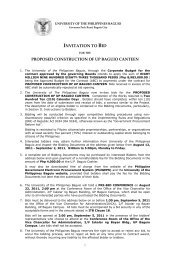Tanzania Report
Tanzania Report
Tanzania Report
You also want an ePaper? Increase the reach of your titles
YUMPU automatically turns print PDFs into web optimized ePapers that Google loves.
REDD+, beneficiaries are likely to include<br />
individuals, groups, village governments,<br />
local governments and even national<br />
government agencies managing forest areas<br />
(such as wildlife division, TANAPA and<br />
FBD).<br />
• “Co-mingling”(ormixing)ofdifferentfunds<br />
isunlikely.Current government policy seeks<br />
to reduce transaction costs by amalgamating<br />
and clustering government transfers under<br />
simplified and unified systems. Development<br />
partners—together with government—have<br />
signed agreements at the national and<br />
international level designed to align and<br />
harmonize external development funds with<br />
those of government. It is likely that any<br />
future REDD+ fund will have to be entirely<br />
“stand-alone” and will not be permitted to<br />
mix funds with other government funding<br />
sources directed, for example to natural<br />
resource management. Further questions<br />
remain, however, regarding the relationship<br />
between the REDD+ fund and the “Forest<br />
Fund” which is mandated under the 2002<br />
Forest Act, for the purpose of furthering<br />
forest conservation and management in<br />
<strong>Tanzania</strong>, and which will be established<br />
through retaining a small percentage of<br />
all royalties, levies and taxes collected on<br />
the harvesting, transport and sale of forest<br />
produce.<br />
As a result of these fundamental differences,<br />
it is quite likely that transfers to and from a<br />
REDD+ fund will take place outside any routine<br />
local government block grant transfer system<br />
and that the establishment of some kind of<br />
parallel structure seems inevitable. Given this,<br />
it will be important to consider a number of<br />
different options with regard to the design and<br />
establishment of this fund.<br />
•<br />
Paymentsmadeentirelybasedon<br />
performanceinreducingemissionsfrom<br />
deforestationandforestdegradation.<br />
Payments made from national to subnational<br />
level will be linked in some<br />
way, to evidence of reduced (or avoided)<br />
deforestation and forest degradation. One<br />
option open to government would be to<br />
make these payments entirely performance<br />
based, with the result that payments would<br />
only flow to management agents who have<br />
made demonstrable emission reductions<br />
as a result of improvements in forest<br />
management. This would require projections<br />
of emission reductions from REDD+<br />
not only at national level but at a more<br />
disaggregated level (such as regions, zones<br />
or ecotypes), and the ability to monitor these<br />
independently. The advantage of a system<br />
entirely based on performance is that it is<br />
transparent, verifiable and relatively simple<br />
to maintain, once it has been established.<br />
A possible disadvantage of such a scheme<br />
is that it may lead to funds flowing to those<br />
institutions or agents that already possess<br />
capacity (such as national government<br />
agencies involved in the protection or<br />
management of forest landscapes, or private<br />
corporations with established systems<br />
and capacity). Weak institutions (such<br />
as village governments or community<br />
based organizations) with an interest and<br />
mandate in forest management, but with<br />
limited capacity, would be disadvantaged<br />
by a system entirely based on performance.<br />
This is an inherent weakness that has<br />
already been recognized within routine<br />
local government transfer systems and has<br />
been addressed through the introduction of<br />
“capacity building grants,” aimed at assisting<br />
local government authorities who fall short<br />
8<br />
Participatory Forest Management and REDD+ in <strong>Tanzania</strong>


